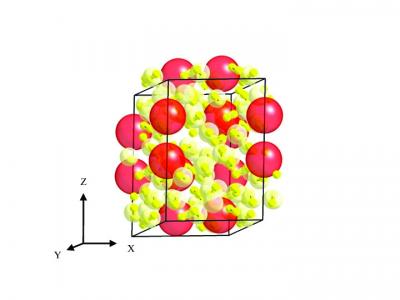
New hydrogen-storage method discovered
Scientists at the Carnegie Institution have found for the first time that high pressure can be used to make a unique hydrogen-storage material. The discovery paves the way for an entirely new way to approach the hydrogen-storage problem. The researchers found that the normally unreactive, noble gas xenon combines with molecular hydrogen (H2) under pressure to form a previously unknown solid with unusual bonding chemistry. The experiments are the first time these elements have been combined to form a stable compound. The discovery debuts a new family of materials, which could boost new hydrogen technologies.
The paper is published in the November 22, 2009, advanced online publication of Nature Chemistry.
Xenon has some intriguing properties, including its use as an anesthesia, its ability to preserve biological tissues, and its employment in lighting. Xenon is a noble gas, which means that it does not typically react with other elements.
As lead author Maddury Somayazulu, research scientist at Carnegie's Geophysical Laboratory, explained: "Elements change their configuration when placed under pressure, sort of like passengers readjusting themselves as the elevator becomes full. We subjected a series of gas mixtures of xenon in combination with hydrogen to high pressures in a diamond anvil cell. At about 41,000 times the pressure at sea level (1 atmosphere), the atoms became arranged in a lattice structure dominated by hydrogen, but interspersed with layers of loosely bonded xenon pairs. When we increased pressure, like tuning a radio, the distances between the xenon pairs changed-the distances contracted to those observed in dense metallic xenon."
>
"Xenon is too heavy and expensive to be practical for use in hydrogen-storage applications," remarked Somayazulu. "But by understanding how it works in this situation, researchers can come up with lighter substitutes."
>
Scientists at the Carnegie Institution have found for the first time that high pressure can be used to make a unique hydrogen-storage material. The discovery paves the way for an entirely new way to approach the hydrogen-storage problem. The researchers found that the normally unreactive, noble gas xenon combines with molecular hydrogen (H2) under pressure to form a previously unknown solid with unusual bonding chemistry. The experiments are the first time these elements have been combined to form a stable compound. The discovery debuts a new family of materials, which could boost new hydrogen technologies.
The paper is published in the November 22, 2009, advanced online publication of Nature Chemistry.
Xenon has some intriguing properties, including its use as an anesthesia, its ability to preserve biological tissues, and its employment in lighting. Xenon is a noble gas, which means that it does not typically react with other elements.
As lead author Maddury Somayazulu, research scientist at Carnegie's Geophysical Laboratory, explained: "Elements change their configuration when placed under pressure, sort of like passengers readjusting themselves as the elevator becomes full. We subjected a series of gas mixtures of xenon in combination with hydrogen to high pressures in a diamond anvil cell. At about 41,000 times the pressure at sea level (1 atmosphere), the atoms became arranged in a lattice structure dominated by hydrogen, but interspersed with layers of loosely bonded xenon pairs. When we increased pressure, like tuning a radio, the distances between the xenon pairs changed-the distances contracted to those observed in dense metallic xenon."
>
"Xenon is too heavy and expensive to be practical for use in hydrogen-storage applications," remarked Somayazulu. "But by understanding how it works in this situation, researchers can come up with lighter substitutes."
>

